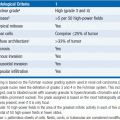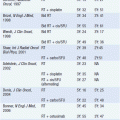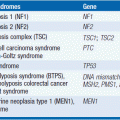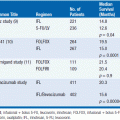Localized Breast Cancer
Breast cancer is considered “localized” if it is technically possible to excise cancerous tissue, if the tumor does not involve the skin or structures deep to the breast, and if the tumor has not metastasized beyond the axillary or internal mammary lymph nodes.
A variety of prognostic and predictive factors influence the choice of treatment of localized breast cancer, including the status of cancer in the axillary lymph nodes, tumor size, hormone receptor status, HER2/neu status, and a woman’s age or menopausal status.
PROGNOSTIC AND PREDICTIVE FACTORS
• Lymph node involvement—Fluid from the breast tissue normally drains into lymph nodes located in the axilla, and cancerous involvement of these nodes is an indication of the likelihood that breast cancer has spread and could be present in distant organs. Women with node-positive breast cancer are generally offered chemotherapy, hormone therapy, or both after local treatment, even if the tumor was completely removed. The type of systemic treatment that is recommended depends upon whether the breast cancer expresses hormone receptors and/or the protein HER2/neu.
• Size and extent of the tumor—In addition to lymph node status, the prognosis of a breast cancer depends upon its size, since larger tumors (<2 cm) recur more often. In some cases, chemotherapy may be given before surgery to shrink a large tumor (>5 cm) or one that has grown into the chest wall.
• Histology—There are several histologic types of breast cancer. However, from the standpoint of treatment, the most important distinction is between invasive and noninvasive (in situ) breast cancer. The surgical treatment of in situ cancers is similar to that of invasive cancers, but axillary nodal dissection is generally not recommended.
• Hormone receptor status—Estrogen receptor (ER) and progesterone receptor (PR) assays are routinely performed by pathologists on tumor material. Women with hormone receptor-positive tumors benefit from postoperative endocrine treatments such as tamoxifen, or in postmenopausal women, the aromatase inhibitors (anastrozole, letrozole, or exemestane). For premenopausal women, ovarian ablation or suppression can be considered, but evidence regarding its efficacy from randomized clinical trials is currently lacking. Hormone therapy is not beneficial for women with hormone receptor-negative tumors.
• HER2/neu status—Assays for HER2/neu status are routinely performed on the tumor material. Women with invasive tumors that overexpress HER2/neu benefit from postoperative trastuzumab, a monoclonal antibody directed at HER2/neu.
• Age and/or menopausal status—Women who are under the age of 50 years or premenopausal at the time of breast cancer diagnosis derive more benefit from adjuvant systemic chemotherapy than postmenopausal women. Postmenopausal women have a lesser absolute benefit in reduction of recurrence risk than premenopausal women but still can have some benefit from adjuvant chemotherapy.
SURGERY FOR LOCALIZED BREAST CANCER
Generally, surgical options for women with localized breast cancer include breast conserving therapy (BCT) and irradiation or mastectomy.
• BCT—BCT offers women the option of preserving the breast without compromising survival. The tumor is surgically removed to achieve clear tumor-free margins without removing excess amounts of normal breast tissue. BCT is followed by radiation therapy (RT), either to the entire breast or just to the original tumor site (partial breast irradiation) to eradicate residual disease. BCT plus radiation provides a survival outcome equivalent to mastectomy but allows women to preserve the breast (1).
• Absolute contraindications to BCT:
• Persistently positive resection margins after re-excision attempts
• Multicentric disease with two or more primary tumors in separate breast quadrants
• Diffuse malignant-appearing microcalcifications on mammography
• History of prior RT to the breast or chest wall that precludes further RT
• Inflammatory breast cancer
• Relative contraindications to BCT:
• History of connective tissue disease (particularly scleroderma) because RT is generally tolerated poorly
• Large tumor or small breast that would lead to a significantly poor cosmetic outcome
• Mastectomy—Mastectomy refers to the surgical removal of the breast. There are several different types of mastectomy.
• Radical mastectomy: is the most extensive surgical procedure and is no longer routinely performed nor is it indicated. The breast is removed along with the pectoralis major and minor muscles and some overlying skin (at least 4 cm on each side of the tumor biopsy site), and there is an en bloc resection of all axillary contents, including lymph nodes beyond the subclavian vein.
• Modified radical mastectomy: removes the entire breast and includes an axillary dissection, in which the level I and II axillary lymph nodes are also removed. Most women who have mastectomies today for invasive breast cancer have modified radical mastectomies.
• Simple or total mastectomy: removes the entire breast and a small amount of skin but does not remove the axillary lymph nodes. A total mastectomy is appropriate for women with ductal carcinoma in situ (DCIS) and for women seeking prophylactic mastectomies—that is, breast removal in order to prevent any possibility of breast cancer occurring. In prophylactic simple mastectomy, overlying skin and nipple may be spared.
MANAGEMENT OF THE REGIONAL LYMPH NODES
Axillary lymph node dissection (ALND) has traditionally been used to manage localized breast cancer both to prevent an axillary recurrence and to provide prognostic information. Axillary metastases are an important indicator of the need for adjuvant systemic therapy and postmastectomy RT.
Complications of ALND include:
• Injury or thrombosis of the axillary vein
• Injury to the motor nerves
• Lymphedema of the upper extremity
• Seroma formation
• Shoulder dysfunction
• Loss of sensation
Sentinel node biopsy (SLNB) is routinely used for women with breast cancer without palpable axillary lymphadenopathy. SLNB is possible because breast tumor cells migrating from a primary tumor drain to one or a few axillary lymph nodes before involving other axillary nodes. Injection of a vital blue dye and/or radioactive colloid in the breast area permits intraoperative identification of the sentinel lymph node(s). The status of the SLN accurately predicts the status of the remaining regional nodes (2).
RADIATION THERAPY (RT) FOR LOCALIZED BREAST CANCER
RT is routinely delivered after BCT and may also be indicated after mastectomy, particularly for large primary tumors. The intent of RT is to eradicate subclinical residual disease and to minimize local recurrence rates. RT should be considered in almost all subgroups of women with breast cancer. Even in patients with the lowest risk disease with the most favorable prognostic features (e.g., low grade tumor, ER+, small size), whole breast RT reduces the rate of local recurrence by 75% regardless of whether adjuvant systemic therapy is used (3).
RT after BCT may be avoided in two circumstances:
• Elderly women taking hormonal therapy for ER+ breast cancer—In women over age 70 years with ER+ tumors no larger than 2 cm, RT decreased the rate of in-breast recurrence by 75%, but the overall rate of local recurrence in these women taking tamoxifen is so low that very few actually benefit from RT (4).
• Well-differentiated DCIS—If the resection margins are adequate, it is possible that RT can be avoided but this is very controversial.
Postmastectomy RT in women with larger (>5 cm) tumors or axillary lymph node-positive disease reduces the risk of locoregional recurrence, increases disease-free survival, and reduces the risk of dying from breast cancer. Women with > 5cm tumors or >4 positive axillary lymph nodes are routinely offered postmastectomy RT. The benefit of RT for women with 1–3 positive lymph nodes is uncertain. The treatment field usually includes the chest wall and supraclavicular and infraclavicular regions.
ADJUVANT SYSTEMIC THERAPY
Adjuvant systemic therapy is the administration of hormonal therapy, chemotherapy, and/or trastuzumab (a humanized monoclonal antibody directed against HER2/neu) after definitive local therapy for breast cancer. Adjuvant therapy significantly reduces the risk of both recurrence and death from breast cancer.
Hormonal Therapy—Hormonal therapy is directed toward reducing estrogen and thereby blocking the growth of cancer cells that require estrogen to proliferate. Hormone receptor (ER and/or PR)-positive breast cancer requires estrogen to grow while hormone receptor-negative breast cancers are not dependent on estrogen for growth. Therefore, hormonal therapy is only effective in hormone receptor-positive breast cancers.
Hormonal therapies include:
• Tamoxifen—an oral selective estrogen receptor modulator (SERM).
• Aromatase inhibitors (letrozole, anastrozole, or exemestane)—only for postmenopausal women. In premenopausal women, these drugs are ineffective as inhibition of aromatase results in reduced feedback of estrogen to the hypothalamus and pituitary, leading to increased gonadotropin secretion and increased ovarian production of estrogen.
• Fulvestrant—an injectable pure anti-estrogen.
• Ovarian function suppression or ablation—via surgical removal of the ovaries, irradiation of the ovaries, or use of luteinizing hormone releasing hormone analogs (e.g., goserelin or leuprolide).
Benefits of hormonal therapy—Data from the Early Breast Cancer Trialists Collaborative Group (EBCTCG) showed that 5 years of tamoxifen reduces the annual risk of breast cancer recurrence by about 40% and decreases the annual risk of death by about 35% in patients with ER-positive localized breast cancer (5). Adjuvant tamoxifen followed by aromatase inhibitor is one of the standard options for postmenopausal women with ER-positive localized breast cancer and is the only standard option for premenopausal women with ER-positive localized breast cancer. Aromatase inhibitors for postmenopausal women—Several randomized clinical trials of postmenopausal women with localized hormone receptor-positive breast cancer have shown that adjuvant use of aromatase inhibitors, either used upfront or sequenced after tamoxifen, is superior to tamoxifen alone or placebo in terms of disease-free survival and rates of contralateral breast cancer (6–8). An aromatase inhibitor should be considered as a component of adjuvant hormonal therapy in all postmenopausal women with hormone receptor-positive breast cancer (9).
Side effects of hormonal therapy generally include vasomotor complaints and vaginal discharge and/or atrophy. Although rare, tamoxifen is also associated with an increased risk of uterine cancer, thromboembolic events, and cerebral vascular accidents. Aromatase inhibitors are also associated with loss of bone density, increased risk of bone fractures, musculoskeletal aches, and modestly increased cholesterol.
Chemotherapy—Adjuvant chemotherapy is generally recommended for:
• Women with hormone receptor-negative breast cancer, particularly if they have positive lymph nodes, larger tumors, or other adverse features
• Women with node-positive breast cancer, regardless of hormone receptor status.
• Women with HER2/neu overexpressed breast cancer with trastuzumab
Adjuvant chemotherapy can benefit both premenopausal and postmenopausal women with localized breast cancer irrespective of hormone receptor status, although the absolute magnitude of benefit is greater in younger as compared to older women. The EBCTCG 2000 overview (5) concluded that adjuvant administration of two or more chemotherapy agents:
• For women under age 50 years and with node positive disease, chemotherapy reduces the risk of relapse by 37% and death by 30%. This results into a 10% absolute improvement in 15-year survival.
• For women ages 50–69 years, chemotherapy reduces the risk of relapse by 19% and death by 12%. This results in a 3% absolute improvement in 15-year survival.
• For women over age 70 years, the benefits of chemotherapy are uncertain because few studies include women in this age group.
The benefit of adding chemotherapy to hormonal therapy for women with hormone receptor-positive, node-negative breast cancer is unclear.
There are many choices of adjuvant chemotherapy regimens (Table 58-1). There is a modest but significant additional benefit for anthracycline-containing regimens such as (doxurobicin plus cyclophosphamide, or AC) compared to nonanthracycline-containing regimens (such as cyclophosphamide, methotrexate, plus fluorouracil [CMF]). A taxane is often considered for premenopausal and postmenopausal women with node-positive breast cancer.
TABLE 58-1 COMMON ADJUVANT CHEMOTHERAPY REGIMENS FOR HER2/NEU NON-OVEREXPRESSING EARLY STAGE BREAST CANCER
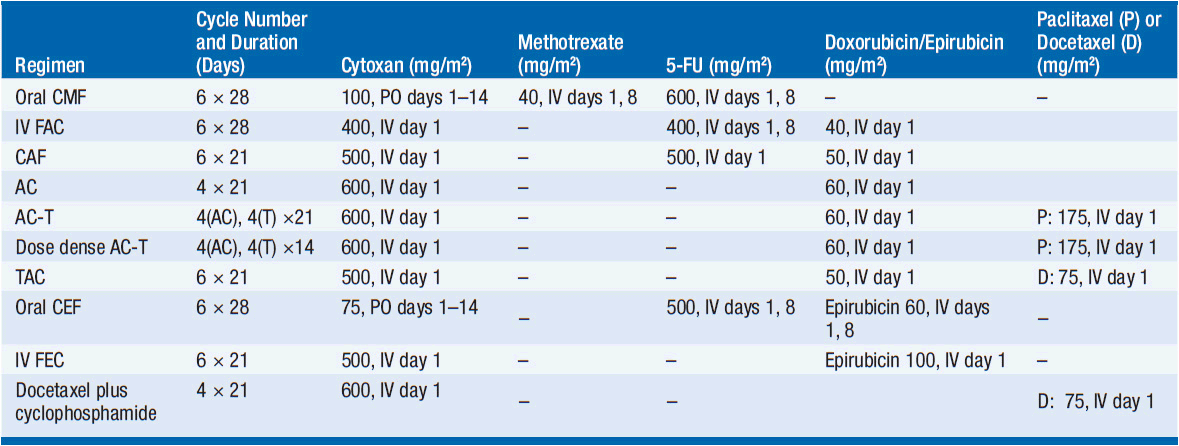
Stay updated, free articles. Join our Telegram channel

Full access? Get Clinical Tree


